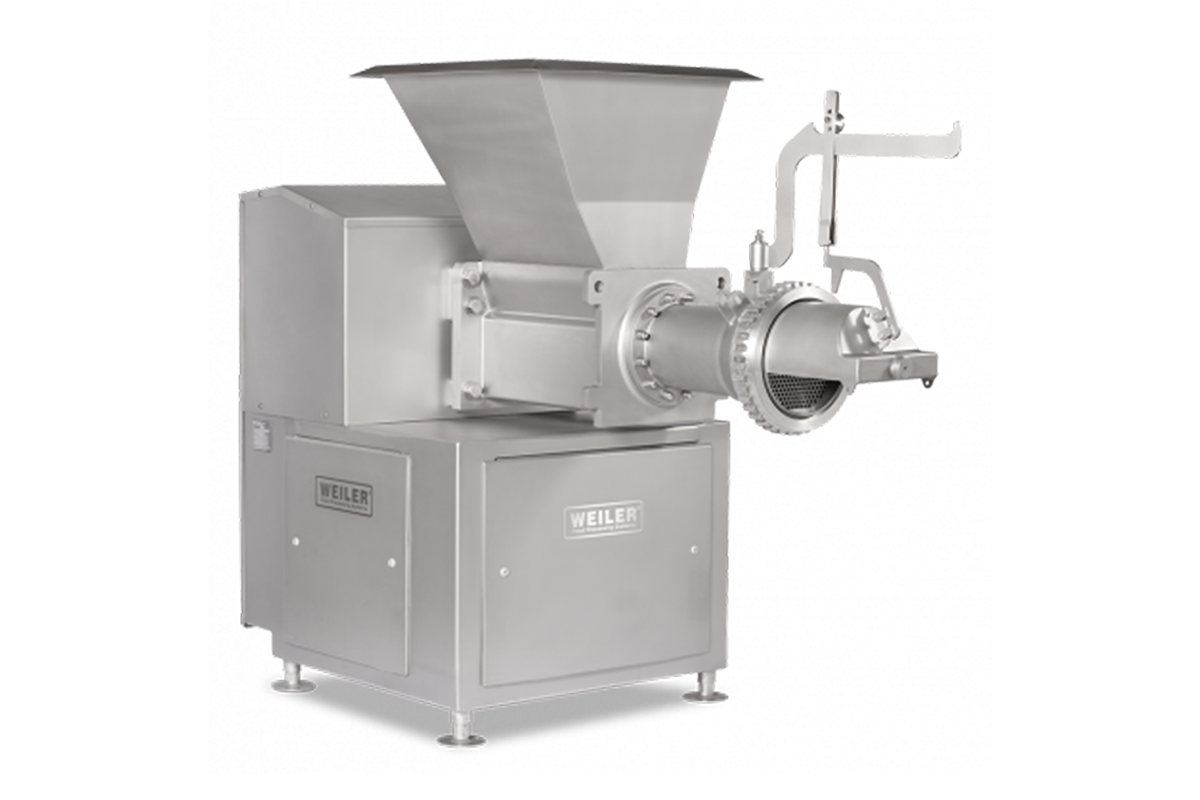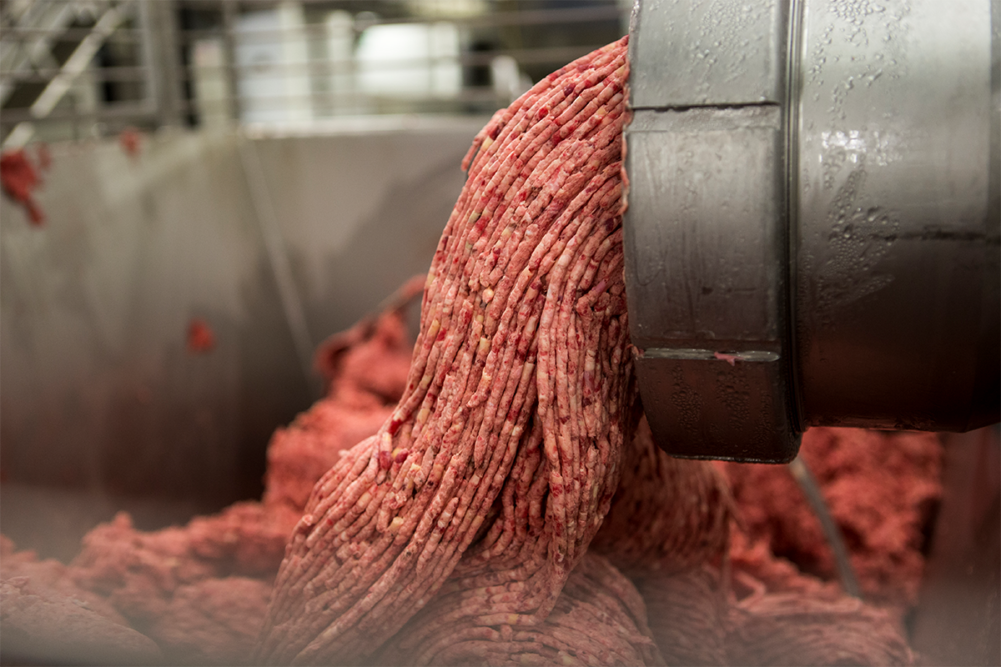Monitoring, controlling, reporting, flexibility and labor independence are the key words when it comes to mixing and grinding equipment in 2023.
From a technology standpoint, fully automated grinding/mixing lines continue to grow, especially outside the United States. While these automated systems have been around for more than a decade, the majority were used by large processors for quick-service restaurant products where today, more small- and medium-size processors are taking advantage of the technology.
“Part of this trend is due to the lack of staffing which was magnified due to the COVID-19 pandemic,” said Jeff Braunreiter, global sales support manager for Mokena, Ill.-based Provisur Technologies. “While less people were either not able to work or choosing not to, the ground beef demand did not decrease, it actually grew. One way for processors to overcome the employment shortage while keeping up with demand was to automate as much as possible.”
Provisur was able to react quickly to these customers and offer a solution that had proven successful. The company offers mixing and grinding equipment through its Weiler product line, with various sizes of mixers and vacuum mixers as well as mixer grinders, which can suit small one-person operations up to machines that can produce 2 million lbs per day.
“We have a very robust model selection for all size grinders for a wide variety of common and unique applications — small grinders for fresh product or very large grinders for frozen blocks,” Braunreiter said. “We have a grinder for almost every application and were one of the first manufacturers of food processing grinders before grinders were being used for human consumption food. We also offer a wide variety of material handling equipment to get product in and out of our mixers and grinders.”
Lenexa, Kan.-based Marel has a variety of equipment in its portfolio, starting with grinders for both fresh and frozen blocks, fat analyzers, mixers, emulsifiers for sausage production up to conveyor and silo systems.
“The Marel philosophy is that the operator should not control the line, but the line should control the operator,” said Ruben Sorensen, global product manager, preparation for Marel. “To this effect, the intelligent online recipe monitoring system has been integrated in Marel’s preparation lines, turning decision-making into a purely data-driven process. Once the operator has chosen the recipe on the main touch panel, the system will automatically change all settings of the machines in the line.”
This goes for grinder settings, belt speed, mixing program, etc. The recipe system is always guiding the operator step by step what to do and the operator needs to confirm each completed task before proceeding to the next task. After each batch, a report will be stored in the database for further documentation.
“These full-line solutions have been designed to fulfill the requirements for the consistent production of burgers, minced meat, meatballs, dry sausages, sausages and nuggets,” Sorensen said. “Focus is on creating the most efficient lines, needing the fewest operators, while gently handling the meat to prevent protein destruction.”
Sam Pantano, senior vice president of sales and marketing for Hollymatic, Countryside, Ill., noted everyone is trying to automate as much of the process as possible. That includes conveyors feeding product direct into grinders; conveyor from grind head direct into forming equipment; and shuttle conveyors to auto load the packaging line.
The company offers mixers and grinders to partner with processors of all sizes, with machines with grind head sizes from 32 to 66.
“We recommend and help to develop automated lines to drive efficiency and greater throughput,” Pantano said. “We’re always looking for the next greatest trend that provides the highest quality and safest piece of equipment.”
 Provisur's Weiler equipment offers various sizes of mixers as well as flexible mixer-grinders. (Source: Provisur)
Provisur's Weiler equipment offers various sizes of mixers as well as flexible mixer-grinders. (Source: Provisur) Evolving equipment
Today’s mixing and grinding equipment allows for more products, faster changeover from one product type to the next, and greater flexibility.
“Flexibility is more important than ever for modern food producers,” Sorensen said. “It is crucial to be able to make fast changeovers of recipes and line configurations, depending on the incoming customer orders.”
Reiser, headquartered in Canton, Mass., supplies a wide range of stand-alone Seydelmann Mixers, Seydelmann Grinders and a Vemag Vacuum Stuffer inline grinder.
“One of the latest innovations in ground beef processing is the continuous formulation system that analyzes fat and lean and will make adjustments in real time,” said Stefan Neumann, meat specialist at Reiser. “This eliminates the need to make fat and lean adjustments in the mixer which in turn reduces the mix time for each batch.”
Another innovation is the availability of large capacity bowl cutters (like the Seydelmann Bowl Cutters), which provides the option of low pressure particle reduction and being able to replace enterprise-style grinders.
“A better industry understanding of grinder technology has opened the door for use of positive displacement grinding and again recognizing the quality aspect of low pressure grinding versus high-pressure grinding,” Neumann said.
The automation system that Reiser offers as a grinding line solution has a unique grinding system that uses amperage as a feed control mechanism. By monitoring the amperage of the feed screw, the grinder delivers a constant pressure on the grinding knives and plate, providing more consistent product, reduces back flow of product, and improves bone and cartilage removal.
While the major benefit of an automated line is the reductions of labor force that is required to run a line, sophisticated electrical controls also allow communication between all the equipment and removes the need for human interaction. This means you do not need people to start/stop all the machines and move the meat carts from machine to machine.
“When you eliminate the need for the meat carts, you eliminate the space the carts take up as well as the labor force and time needed to keep the carts clean,” Braunreiter said. “Safety is another major benefit to this technology. The less people working on the production floor pushing carts around, the less chance for injury. All guarding and safety mechanisms that are in place on the equipment can be monitored on the screens of the central electrical system. This means less downtime and a guarantee that the equipment will not run if all safety mechanisms are not in place.”
Looking ahead
Without giving away any plans for his own brand, Braunreiter noted it’s clear the future is going to include more sophisticated technology features in equipment.
“Making sure the customer has the best possible products from our company, that in the end, will help create greater profit margins for our customers while keeping up with the demand of the market,” he said.
Sorensen sees the future as one with more automation and digitalization, addressing issues such as sustainability, labor shortage and food safety.
“One of the new aspects in the near future will be visual and X-ray detection of foreign products such as metal, bone, plastic and other objects,” he said. “Data-driven intelligence will result in a major role for the central control room. Monitoring, controlling and reporting will take place there.
“Further ahead, data will be available in the cloud, absolutely secured of course, accessible from any mobile device,” Sorensen said, adding, “Remote control and support will get a new dimension.”

